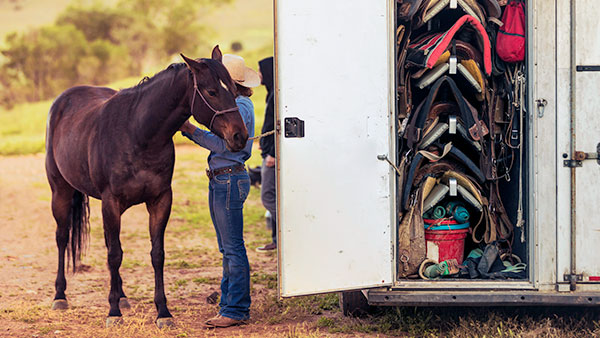
Make sure your horse is comfortable being loaded into a trailer. Plan to take tack and other supplies you may need.
Having a disaster plan is critical to keeping your animal companions safe. And horses require extra consideration because of their size and specific transportation needs.
In an emergency you may not have much time to safely evacuate your animals, so advance preparation is essential. Consider these best practices when creating an equine evacuation plan:
- Familiarize yourself with the types of disasters that could occur in your area. Survey your property and the surrounding area for the most appropriate evacuation route for each disaster type (wildfire, flood, earthquake, hurricane, etc.). Confirm that the exit route can accommodate your trailer and is passable in all weather conditions.
- Develop and rehearse your plan with a neighbor and consider sharing resources such as a trailer and supplies during an evacuation. This may help you to evacuate the animals in a shorter amount of time.
- Make plans early. If you will need to rely on a horse transportation company, be sure to make advance arrangements for emergency transportation.
- Arrange for an emergency boarding of your horses. The county fairgrounds may be an appointed shelter for livestock, horses and pets, as well as their displaced owners.
- Check with the emergency transporter and boarder to see what health records are required. Many service providers require records of a negative Coggins test to prove the horse does not have the very contagious Equine Infectious Anemia virus. Be sure your horse’s test and all vaccinations and boosters are up to date. Document the dates and dosages of any medications for each animal and keep all medical records in a safe place.
- Permanently identify each horse by tattoo, microchip, brand or photograph. In your records, include the horse’s age, sex, breed and color. Keep this information with your important papers. If you have not had your horses microchipped, tattooed or branded, you can paint your contact number on the horse.
- Practice loading your horses into a trailer. If they are not accustomed to being loaded, they may need time to become comfortable. Keep your trailer in an accessible location and in acceptable condition for emergency hauling.
- Stockpile an ample supply of feed and hay to take with you. In addition to three days’ worth of feed and hay, provide an emergency supply of all medications for each animal.
- Prioritize tack for an evacuation and create a checklist to streamline the evacuation process. Ropes and halters are most important. To assist with identification, create an identity halter with a metal or brass plate riveted to a leather halter; metal dog tags also can serve this purpose.
- Don’t wait until the last minute to evacuate. If you wait too long, emergency management officials may require you to leave your horses behind.
- Practice! Remember to practice your emergency evacuation plan!
This loss control information is advisory only. The author assumes no responsibility for management or control of loss control activities. Not all exposures are identified in this article. Contact your local, independent insurance agent for coverage advice and policy service.
